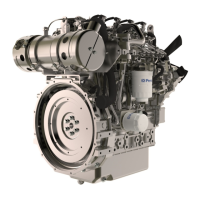Improper jump start cable connections can cause
an explosion resulting in personal injury.
Prevent sparks near the batteries. Sparks could
cause vapors to explode. Do not allow jump start
cable ends to contact each other or the engine.
Note: If possible, first diagnose the reason for the
starting failure. Refer to Troubleshooting, “Engine
Will Not Crank and Engine Cranks But Will Not Start”
for further information. Make any necessary repairs.
If the engine will not start only due to the condition of
the battery, either charge the battery, or start the
engine by using another battery with jump-start
cables. The condition of the battery can be
rechecked after the engine has been switched OFF.
NOTICE
Using a battery source with the same voltage as the
electric starting motor. Use ONLY equal voltage for
jump starting. The use of higher voltage will damage
the electrical system.
Do not reverse the battery cables. The alternator can
be damaged. Attach ground cable last and remove
first.
Turn all electrical accessories OFF before attaching
the jump start cables.
Ensure that the main power switch is in the OFF posi-
tion before attaching the jump start cables to the en-
gine being started.
1. Turn the start switch on the stalled engine to the
OFF position. Turn off all the engines accessories.
2. Connect one positive end of the jump-start cable to
the positive cable terminal of the discharged
battery. Connect the other positive end of the
jump-start cable to the positive cable terminal of
the electrical source.
3. Connect one negative end of the jump-start cable
to the negative cable terminal of the electrical
source. Connect the other negative end of the
jump-start cable to the engine block or to the
chassis ground. This procedure helps to prevent
potential sparks from igniting the combustible
gases that are produced by some batteries.
Note: The engine ECM must be powered before the
starting motor is operated or damage can occur.
4. Start the engine in the normal operating
procedure. Refer to this Operation and
Maintenance Manual, “Starting the Engine”.
5. Immediately after the engine is started, disconnect
the jump-start cables in reverse order.
After jump starting, the alternator may not be able to
recharge fully batteries that are severely discharged.
The batteries must be replaced or charged to the
proper voltage with a battery charger after the engine
is stopped. Many batteries which are considered
unusable are still rechargeable. Refer to Operation
and Maintenance Manual, “Battery - Replace” and
Testing and Adjusting Manual, “Battery - Test”.
i06288297
After Starting Engine
After starting, the engine may be held at low speed
for up to 30 seconds to allow engine systems to
stabilize. The duration will depend on ambient
temperature, time since last run and other factors.
Note: In ambient temperatures from 0° to 48°C
(0° to 86.4°F), the warm-up time is approximately 3
minutes. In temperatures below 0°C (32°F),
additional warm-up time may be required.
When the engine idles during warm-up, observe the
following conditions:
Do not check the high-pressure fuel lines with the
engine or the starting motor in operation. If you
inspect the engine in operation, always use the
proper inspection procedure to avoid a fluid
penetration hazard. Refer to Operation and
Maintenance Manual, “General hazard Information”.
• Check for fluid and air leaks at idle rpm, and at
one-half full rpm (no load on the engine) before
operating the engine under load. This check may
not possible in some applications.
• Allow the engine to idle for 3 to 5 minutes, or allow
the engine to idle until the water temperature
indicator begins to rise. Check all gauges during
the warm-up period.
Constant speed engines should be allowed to
operate at low idle for 3 minutes before used at
operational speed. If the low idle option is not
available, then operate the engine at operational
speed with no load for 2 minutes.
Note: Gauge readings should be observed and the
data should be recorded frequently whilst the engine
is operating. Comparing the data over time will help
to determine normal readings for each gauge.
Comparing data over time will also help detect
abnormal operating developments. Significant
changes in the readings should be investigated.
48
SEBU9075-03
Operation Section
After Starting Engine

